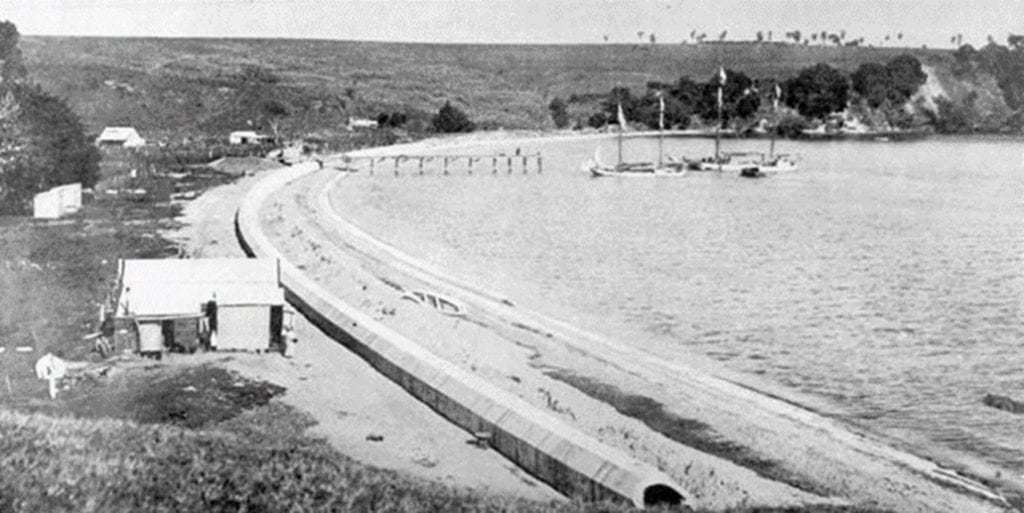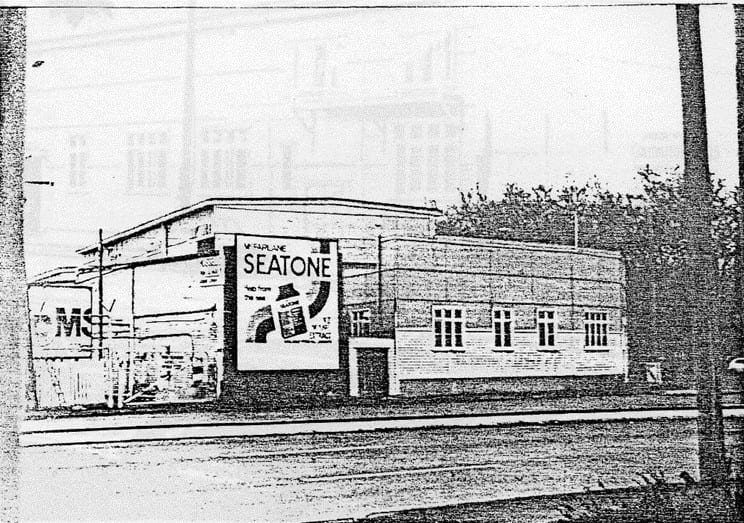Part Three
Resilience
by Nicolas Jones*
The Māori Community Centre, set up in 1947, was an important component in the reestablishment of Ngāti Whātua Ōrākei’s community identity. During a period of significant upheaval and devastation for Ngāti Whātua, the Centre provided space for a temporary Marae and supported the process of rebuilding within the hapū. In understanding the role the Maori Community Centre played for Ngāti Whātua Ōrākei, it is necessary to outline the trials faced by the hapū in the early-to-mid twentieth century. In particular, the encroachment of urban sprawl onto Ngāti Whātua Ōrākei’s land set in motion a series of devastating events, cumulating in the destruction of Ngāti Whātua Ōrākei’s marae.

Sewer under construction, Ōkahu Bay, 1910. Rāwiri Taonui, ‘Ngāti Whātua – Ngāti Whātua and the Treaty of Waitangi’, Te Ara – the Encyclopaedia of New Zealand, http://www.TeAra.govt.nz/en/photograph/1559/sewer-under-construction-okahu-bay-1910
At the beginning of the twentieth century, there were two key events that negatively impacted Ngāti Whātua. In the first instance, the increasing urban population of Auckland required extensive public works to be carried out in order to install and update urban utilities. While objected to by Ngāti Whātua in 1905, the Government nonetheless passed an Act of Parliament to confiscate the land at Ōkahu Bay so a sewer pipe could be installed across the beachfront, in front of Ngāti Whātua Ōrākei’s ancestral village (shown above).[1] This sewer pipe, completed in 1910, began a series of devastating events that impacted Ngāti Whātua. Not only did Auckland’s effluent discharge into Ōkahu Bay, contaminating Ngāti Whātua seafood beds, but the pipeline also prevented surface run-off into the ocean.[2]

Ōkahu Bay. Christine Dann, “Sewage, water and waste – Water pollution,” Te Ara – the Encyclopedia of New Zealand, http://www.TeAra.govt.nz/en/photograph/24463/okahu-bay
As a result, not only was Ngāti Whātua deprived of their kaimoana, but their ancestral village was swamped. Secondly, as the Waitangi Tribunal has found, the Crown desired to acquire the land for European settlement even though Ōrākei land was considered ‘not for sale’. Consequently, by 1914, the Crown had obtained 460 acres of Ngāti Whātua’s land. While many owners believed they could still keep the sections their homes stood on, this was not the case. Eventually, any Ōrākei tenants who resisted had their land seized under the Public Works Act 1882.
In 1952, another devastating and traumatic act by the Crown was inflicted on Ngāti Whātua Ōrākei. In 1951, the Crown seized the last 12 ½ acres belonging to Ngāti Whātua, leaving them with just the Ōkahu cemetery.[3] While the site on which the old village stood was desired by the Crown for a park, it was also on the route the Queen would take during her official visit in the summer of 1952-1953.[4] As such, on the pretext of the village being an eyesore and potential centre for disease, an image the New Zealand Government did not want to portray to Queen Elizabeth II, combined with the Crown’s want of a park, the remaining occupants of the village were evicted – some having to be physically carried out.[5] Upon eviction, Ngāti Whātua Ōrākei’s village and marae were demolished and burnt (Fig.3), and in July 1952, a playground was established on the site.[6]

“Maori shacks go up in smoke,” New Zealand Herald, 1951, from the Sir George Grey Special Collections, Auckland Libraries, 7-A14286A.
It was in the late 1960s that the Māori Community Centre became a central space for the regeneration of Ngāti Whātua Ōrākei. During its lifetime, the Centre was administered by various Trusts. Most notably, the Community Centre was headed by a Trust Board of fifteen members composed from members nominated by the Waitemata Tribal Executive, Department of Maori Affairs, the Maori Women’s Welfare League and Rotary Clubs until 1951. By 1951, the management of the Centre was handed over to the Tribal Executive, and by 1953, this Executive took over the running of the Centre. However, under this Executive, the Maori Community Centre slowly declined in use. By the late-sixties, it was decided that the Centre was to be placed under the custodianship of the all-male Tribal Committee, the Orākei Marae Trust Board, who ran the Centre until 1974.
Once full control of the Community Centre was transferred to the Orākei Marae Trust Board, the Centre became an important component in the re-establishment of Ngāti Whātua’s marae. As the 1960s brought with it widespread interest in developing a Ngāti Whātua ‘urban marae’, this Tribal Committee instigated valuable work within the Maori Community Centre. As author of The History of Ngāti Whātua (1997) Ani Pihema explained, it was at the Maori Community Centre that the carvings that came to adorn the marae were created, being a place where “We could begin our carving project until the shell of the meeting house was completed and then we could return”. Moreover, it was under the Orākei Marae Trust Board that the Centre functioned as a surrogate Māori space in lieu of a marae which was still being constructed. As Ani Pihema elaborated, “the Maori Community Centre for six years provided a temporary Marae for Auckland Maori needs until Orākei Marae was built.”

Auckland Maori Community Centre Exterior. C.M Kelly, “The Auckland Maori Community Centre In The Context Of Continuity And Change In Maori Society,” (Unpublished Thesis, University of Auckland, 1983), 51.
While this narrative has been one of destruction, it is also one that shows the unwavering resilience of Ngāti Whātua Ōrākei. After experiencing the devastation of their ancestral village and marae at the hands of the crown, Ngāti Whātua were resolute to rebuild their marae. Instrumental in the rebuilding of not only their marae, but also community networks ravaged by the eviction process, was the Maori Community Centre. Not only did the Centre become a space that supported Ngāti Whātua’s continued resilience, but under the Orākei Marae Trust Board, it also became a temporary cultural home in which Ngāti Whātua was able to rebuild, strengthen, and reassert their identity.
*Kia ora, I whakapapa to Tuhoe and Nga Puhi.
Nicholas completed his undergraduate studies at the University of Auckland with a major in History and a minor in Art History, graduating in 2018. He went on to complete Honours in History, graduating with first class honours and in 2020 begun a Masters in Asian Studies at the University of Auckland. His project was focused upon fleshing out the social history of Auckland’s Maori Community Centre.
[1] Christine Dann, “Sewage, water and waste – Water pollution,” Waitangi Tribunal, Report of The Waitangi Tribunal on The Orakei Claim (Wai-9), 103. Retrieved 5 February 2019, https://www.waitangitribunal.govt.nz/publications-and-resources/school-resources/orakei/the-loss-of-the-orakei-block/
[2] Dann, “Sewage, water and waste – Water pollution.”
[3] Ministry of Justice, “The loss of the Orakei block,” accessed 19 September 2016, https://www.waitangitribunal.govt.nz/publications-and-resources/school-resources/orakei/the-loss-of-the-orakei-block/; Eric Schwimmer, ed. The Maori people in the nineteen sixties: A symposium (London: C. Hurst; New York: Humanities, 1968), 176.
[4] Waitangi Tribunal, Report of The Waitangi Tribunal on The Orakei Claim (Wai-9), 6.
[5] ibid, 120.
[6] Ministry of Justice, “The loss of the Orakei block,” 126.
